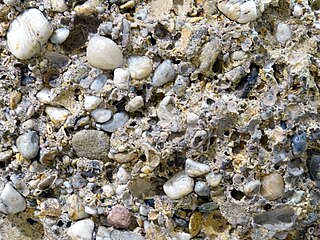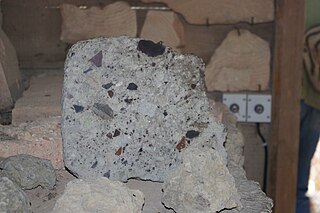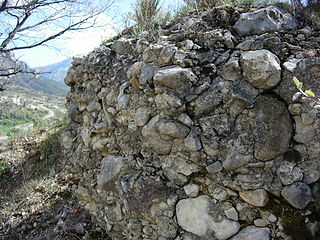Un conglomérat, est une roche détritique, c'est à dire roche sédimentaire composée d'au moins 50 % de débris. Un conglomérat est composé de cailloux ou de galets liés entre eux par un ciment naturel.
Les conglomérats sont déposés par des rivières, des mers ou des glaciers. Il arrive, mais ce n'est pas le cas ici, qu'ils peuvent aussi être d'origine volcanique.
Voici les 3 types de conglomérats :
- le poudingue, composé de galets arrondis ;

- la brèche, composée de blocs anguleux ;

- la tillite, qui contient à la fois des cailloux anguleux et des galets.

Les galets qui constituent les poudingues sont d'origines diverses et ne sont pas forcément homogènes. Le liant quant à lui, est souvent naturel, principalement du grès.
Les poudingues peuvent aussi être classés selon leur taille :
- Micropoudingues : les galets ont un diamètre compris entre 2 et 4 mm.
- Poudingues avellanaires : les galets ont la taille d’une noisette (ce type de poudingue ressemble parfois à du nougat !).
- Poudingues pugilaires : les galets ont la taille d’un poing.
- Poudingues céphalaires : les galets ont la taille d’une tête d'homme.
Les brèches peuvent elles aussi être d'origine sédimentaire, volcanique voir météoritique. Elles souvent plus solidement agglomérées que les poudingues et peuvent alors servir de pierre de construction.
voir aussi : https://fr.wikipedia.org/wiki/Poudingue et https://fr.vikidia.org/wiki/Conglom%C3%A9rat_(g%C3%A9ologie)
QUESTIONS :
Observez le conglomérat horizontal sur le bloc tout proche.
1) S'agit-il d'un poudingue, d'une brêche ou de tilite ? Argumentez
2) Peut-on le classer en fonction de la taille des cailloux ? SI oui, quel est la classe ?
3) En connaissant un peu la géologie des blocs aux alentours, quel est la nature du ciment ?
4) Pourquoi le conglomérat est un preuve supplémentaire que ce lieu était à une époque sous la mer (descriptif) ?
5) Obligatoire : prendre une photo à partir du spot (sans le conglomérat)
Loguez cette cache "Found it" et envoyez-moi vos propositions de réponses soit via mon profil, soit via la messagerie geocaching.com (Message Center), et je vous contacterai en cas de problème."
ENGLISH VERSION
A conglomerate is a detrital rock, that is to say a sedimentary rock composed of at least 50% of debris. A conglomerate is made up of pebbles or pebbles linked together by a natural cement.
The conglomerates are deposited by rivers, seas or glaciers. It happens, but it is not the case here, that they can also be of volcanic origin.
Here are the 3 types of conglomerates:
- the pudding, made up of rounded pebbles;
- the breach, composed of angular blocks;
- tillite, which contains both angular pebbles and pebbles.
The pebbles that make up the pudding are of various origins and are not necessarily homogeneous. The binder, on the other hand, is often natural, mainly sandstone.
Pudding can also be classified according to their size:Micropudding: the rollers have a diameter between 2 and 4 mm.
- Avellanar pudding: the pebbles are the size of a hazelnut (this type of pudding sometimes looks like nougat!).
- Pudding puffs: the pebbles are the size of a fist.
- Cephalar pudding: the pebbles are the size of a man's head.
- The breccias can also be of sedimentary, volcanic or meteoritic origin. They are often more solidly agglomerated than pudding and can then be used as a building stone.
see also: https://fr.wikipedia.org/wiki/Poudingue and https://fr.vikidia.org/wiki/Conglom%C3%A9rat_(g%C3%A9ologie)
QUESTIONS :
Observe the horizontal conglomerate on the nearby block.
1) Is it a pudding, a breach or a tilite? Argue
2) Can we classify it according to the size of the stones? IF yes, what is the class?
3) Knowing a little about the geology of the surrounding blocks, what is the nature of the cement?
4) Why is the conglomerate further proof that this place was at one time under the sea (description)?
5) Mandatory: take a photo from the spot (without the conglomerate)
Log this "Found it" cache and send me your response suggestions either via my profile or via the geocaching.com messaging (Message Center), and I will contact you in case of problems. "